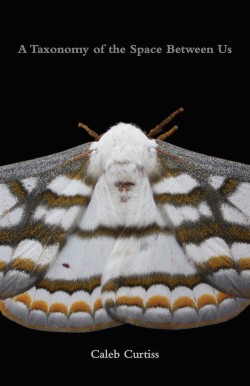37 pages, $8.95
Review by Katie Schmid
Caleb Curtiss’ first chapbook is a chronicle of a sister’s death in a car accident; it is the story of the moment of the death and the moments after. These poems are also poems of memory, as the speaker here watches the past become inflected with (and infected by) the knowledge of the loss that is to come, as in “Self-Portrait With My Dead Sister” where the speaker reflects on a day at the beach with his sister when they were young,
…one will grow up and keep on being real,
while the other will grow up and be dead.
In this memory, the speaker’s sister is already dead though she still lives on the beach. The bald truth of a sister whose memory is both alive and dead seems an obvious enough observation about the nature of loss, but in Curtiss’ poems, it becomes a paradox, something that is troubled and fraught, an obsession—Curtiss questions what it means that his sister can be both real and not real, what it means that he dredges up her memory, over and over, to live in these poems, and finally what the space of grief is for.
There is a reluctance here to engage in the work of grief. In “Sparrow,” the speaker looks at the body of a broken bird and tries to resist thinking of his sister, who would have worried over it,
Even now, I know I could use this moment,
this dying thing to remember her with,
but I don’t want to.
In this piece, the speaker resists the act of memory, but of course even in resisting his sister’s memory, the specter of her loss appears before him. The impulse to refuse memory, and thus refuse loss and grief, runs throughout these poems, but the collection smartly catalogues the cost of such refusal. In “Time Capsule,” the speaker longs to find
…an absence in the center of memory
where order could exist without space, sisters could not
die and the past is always a red thing floating away from me
like a raft.
Ultimately, though, the speaker realizes that the desire to control a chaotic universe and protect himself from grief does not ensure that he can. The poem turns at this point, and the speaker zooms out, examining his past self:
Like the sea in a storm, I did not know
how I was like a storm.
One of the strengths of this collection is the speaker’s ability to both write the visceral space of grief, taking the reader into it, and his ability to rise above it, examine it, and consider its meaning. This collection, finally, is not about the sister. It can’t be; there is no sister, only the absence of one, and this is the space he charts and worries. “I have learned/to grieve formulaically,/while the function of your absence/has grown less and less//integral to my algorithm: you/aren’t even you anymore.”
Curtiss’ strength as a poet comes from his ability to speak in a register that is direct and seemingly simple, and to then subvert the reader’s expectations by working against or complicating his simple language using form. Consider the fourth movement of the poem “Dream,” a poem about the ways the sister and the sister’s death haunts the speaker’s dreams. The poem becomes almost aphoristic in its employment of anaphora; every line is steady and measured, sure in its statement of fact. Each line begins with “this time” until the repetition becomes a litany, building to the stunning conclusion:
This time you blow by the stop sign and everything’s fine.
This time you blow by the stop sign and everything’s fine.
This time you blow by the stop sign and everything’s fine.
This time you say how tired you are.
The repeated phrase becomes a wish, a prayer, a ritual in which all the longing and emotion of the poem live. The final line of the piece leaves the reader with an image—a hallucination of the subconscious, driven by desire and grief—of the sister still living, in the car, remarking on her state of mind. An ordinary image of dailiness, elevated in meaning because of the image’s impossibility.
And it’s his longer poems, his sequence poems, where form and language work against each other most interestingly (look for “Elegy,” “Guncotton,” and the final poem that gives the book its title). In these pieces Curtiss’ work stretches, flexes, and shows the reader what it can do.
***
Katie Schmid has been published in Best New Poets 2009, Quarterly West, Hobart, and The Rumpus, among other places. Her chapbook is forthcoming from Split Lip Press. She lives and writes in Nebraska.
![[PANK]](https://pankmagazine.com/wp-content/themes/pank/assets/images/pank-logo-large.png)

